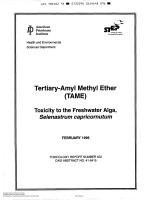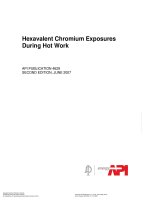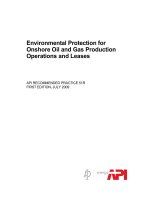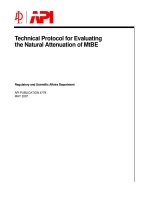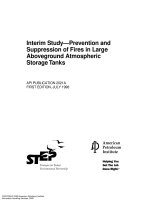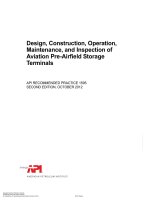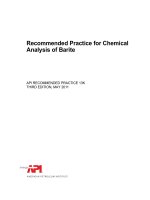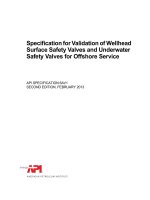Api publ 1645 2002 (american petroleum institute)
Bạn đang xem bản rút gọn của tài liệu. Xem và tải ngay bản đầy đủ của tài liệu tại đây (249.67 KB, 18 trang )
Stage II Vapor Recovery System
Operations & System Installation
Costs
PUBLICATION 1645
FIRST EDITION, AUGUST 2002
--`,,-`-`,,`,,`,`,,`---
Copyright American Petroleum Institute
Provided by IHS under license with API
No reproduction or networking permitted without license from IHS
Not for Resale
--`,,-`-`,,`,,`,`,,`---
Copyright American Petroleum Institute
Provided by IHS under license with API
No reproduction or networking permitted without license from IHS
Not for Resale
Stage II Vapor Recovery System
Operations & System Installation
Costs
Downstream Segment
PUBLICATION 1645
FIRST EDITION, AUGUST 2002
--`,,-`-`,,`,,`,`,,`---
Copyright American Petroleum Institute
Provided by IHS under license with API
No reproduction or networking permitted without license from IHS
Not for Resale
API publications necessarily address problems of a general nature. With respect to particular circumstances, local, state, and federal laws and regulations should be reviewed.
API is not undertaking to meet the duties of employers, manufacturers, or suppliers to
warn and properly train and equip their employees, and others exposed, concerning health
and safety risks and precautions, nor undertaking their obligations under local, state, or federal laws.
Information concerning safety and health risks and proper precautions with respect to particular materials and conditions should be obtained from the employer, the manufacturer or
supplier of that material, or the material safety data sheet.
Nothing contained in any API publication is to be construed as granting any right, by
implication or otherwise, for the manufacture, sale, or use of any method, apparatus, or product covered by letters patent. Neither should anything contained in the publication be construed as insuring anyone against liability for infringement of letters patent.
Generally, API standards are reviewed and revised, reafÞrmed, or withdrawn at least every
Þve years. Sometimes a one-time extension of up to two years will be added to this review
cycle. This publication will no longer be in effect Þve years after its publication date as an
operative API standard or, where an extension has been granted, upon republication. Status
of the publication can be ascertained from the API Downstream Segment [telephone (202)
682-8000]. A catalog of API publications and materials is published annually and updated
quarterly by API, 1220 L Street, N.W., Washington, D.C. 20005.
This document was produced under API standardization procedures that ensure appropriate notiÞcation and participation in the developmental process and is designated as an API
standard. Questions concerning the interpretation of the content of this standard or comments and questions concerning the procedures under which this standard was developed
should be directed in writing to the standardization manager, American Petroleum Institute,
1220 L Street, N.W., Washington, D.C. 20005. Requests for permission to reproduce or
translate all or any part of the material published herein should also be addressed to the general manager.
API standards are published to facilitate the broad availability of proven, sound engineering and operating practices. These standards are not intended to obviate the need for applying sound engineering judgment regarding when and where these standards should be
utilized. The formulation and publication of API standards is not intended in any way to
inhibit anyone from using any other practices.
Any manufacturer marking equipment or materials in conformance with the marking
requirements of an API standard is solely responsible for complying with all the applicable
requirements of that standard. API does not represent, warrant, or guarantee that such products do in fact conform to the applicable API standard.
All rights reserved. No part of this work may be reproduced, stored in a retrieval system, or
transmitted by any means, electronic, mechanical, photocopying, recording, or otherwise,
without prior written permission from the publisher. Contact the Publisher,
API Publishing Services, 1220 L Street, N.W., Washington, D.C. 20005.
Copyright © 2002 American Petroleum Institute
Copyright American Petroleum Institute
Provided by IHS under license with API
No reproduction or networking permitted without license from IHS
Not for Resale
--`,,-`-`,,`,,`,`,,`---
SPECIAL NOTES
FOREWORD
The objective of this report is to provide general cost information that will be useful in
determining the cost impact of proposed air quality regulations. The selection of the appropriate vapor recovery system for a speciÞc site requires the careful evaluation of a variety of
parameters. The report is not intended to compare the feasibility of the various systems or to
provide any guidance in the selection of a particular technology. The cost data was compiled
in 2000 by White Environmental Associates for the American Petroleum Institute.
API publications may be used by anyone desiring to do so. Every effort has been made by
the Institute to assure the accuracy and reliability of the data contained in them; however, the
Institute makes no representation, warranty, or guarantee in connection with this publication
and hereby expressly disclaims any liability or responsibility for loss or damage resulting
from its use or for the violation of any federal, state, or municipal regulation with which this
publication may conßict.
Suggested revisions are invited and should be submitted to the standardization manager,
American Petroleum Institute, 1220 L Street, N.W., Washington, D.C. 20005.
--`,,-`-`,,`,,`,`,,`---
iii
Copyright American Petroleum Institute
Provided by IHS under license with API
No reproduction or networking permitted without license from IHS
Not for Resale
--`,,-`-`,,`,,`,`,,`---
Copyright American Petroleum Institute
Provided by IHS under license with API
No reproduction or networking permitted without license from IHS
Not for Resale
CONTENTS
Page
1
EXECUTIVE SUMMARY. . . . . . . . . . . . . . . . . . . . . . . . . . . . . . . . . . . . . . . . . . . . . . . 1
2
STAGE II PROGRAM BACKGROUND . . . . . . . . . . . . . . . . . . . . . . . . . . . . . . . . . . . 1
3
STAGE II SURVEY ASSUMPTIONS & APPROACH . . . . . . . . . . . . . . . . . . . . . . . . 2
3.1 Survey Assumptions . . . . . . . . . . . . . . . . . . . . . . . . . . . . . . . . . . . . . . . . . . . . . . . . 3
3.2 Survey Approach. . . . . . . . . . . . . . . . . . . . . . . . . . . . . . . . . . . . . . . . . . . . . . . . . . . 3
4
STAGE II DATA COMPILATION AND ANALYSIS . . . . . . . . . . . . . . . . . . . . . . . . 5
5
CLOSING SUMMARY . . . . . . . . . . . . . . . . . . . . . . . . . . . . . . . . . . . . . . . . . . . . . . . . . 6
Table
1
API Stage II Cost Study Survey Data Summary . . . . . . . . . . . . . . . . . . . . . . . . . . . 1
Figures
1
Balance Vapor Recovery System . . . . . . . . . . . . . . . . . . . . . . . . . . . . . . . . . . . . . . . 4
2
ỊPassive Vacuum AssistĨ Vapor Recovery System. . . . . . . . . . . . . . . . . . . . . . . . . . 4
3
Active Vacuum-Assist Vapor Recovery System . . . . . . . . . . . . . . . . . . . . . . . . . . . . 5
v
--`,,-`-`,,`,,`,`,,`---
Copyright American Petroleum Institute
Provided by IHS under license with API
No reproduction or networking permitted without license from IHS
Not for Resale
--`,,-`-`,,`,,`,`,,`---
Copyright American Petroleum Institute
Provided by IHS under license with API
No reproduction or networking permitted without license from IHS
Not for Resale
Stage II Vapor Recovery System Operations & System Installation Costs
1 Executive Summary
3. and active vacuum assist.
The Ịvapor balanc system, conÞgured with a corrugated
bellows over the nozzle spout designed for capturing vapor, has
been in use since vapor recovery was Þrst required. The system
has been reÞned and upgraded with improving technology.
A more recent technology initially pioneered in the Midwest
is the Òpassive vacuum assistÓ system. Initial versions of this
system used reciprocal vacuum pumps for each active nozzle
powered by the ßow of gasoline to the vehicle fuel tank. Subsequent versions of this type of Òdispenser-basedÓ approach use
electrical pumps to return the collected vapor back to the gasoline storage tanks, using electronic signals from the dispenser
meters to regulate the vapor pump speed.
Finally, the Òactive vacuum assistÓ system has also undergone many improvements since it was Þrst used. This system
maintains a vacuum on the entire Stage II recovery system
and processes the excess vapor collected through a central
vapor processor or burner.
A survey of API members and several other sources of
information produced average Stage II installation cost data
representing company-speciÞc typical Stage II system conÞgurations for the three targeted vapor recovery system types.
The collected data was adjusted to conform to a consistent
refueling system conÞguration that should not be considered
typical for the industry. The equipment conÞguration used in
this paper were an equalized number of nozzles, hoses, dispensers and refueling positions for all three types of vapor
recovery systems evaluated. [See Table 1.]
Stage II vapor recovery is a well-known air quality control
measure that reduces ozone precursors from gasoline dispensing facilities (GDFs). As a result of its relative highvisual proÞle, Stage II vapor controls are sometimes proposed
as a part of a regional air quality attainment strategy without
adequately comparing its overall cost effectiveness to other
available control measures. Changes in equipment technology and system testing techniques continue to raise new
issues associated with installing, operating and maintaining
compliance of Stage II systems.
The purpose of this Stage II costs study partially comes from
the U.S. EPAÕs more stringent ozone standard that will bring
additional metropolitan areas into non-attainment status. These
additional metropolitan non-attainment areas may consider
Stage II controls as a priority air quality control measure. As a
further consideration, the U.S. EPA has also implemented an
on-board refueling vapor recovery (ORVR) requirement for
new vehicles. It is designed to capture gasoline vapors at the
nozzle/vehicle gas tank interface during refueling.
Adding to the complexity of the matter, the California Air
Resources Board (CARB), a nationally-recognized lead
agency in the certiÞcation of Stage II equipment and systems,
has recently promulgated major changes to the California
Stage II vapor control program. This is important because
many states have linked their Stage II programs to the CARB
equipment and system certiÞcation process. However, this
paper is focused on the current average cost of installing Stage
II vapor controls to meet the requirements of pre-EVR CARB
approved systems.
This study considered three different types of retail gasoline outlet (RGO) vapor recovery systems:
1. vapor balance,
2. passive vacuum assist,
2 Stage II Program Background
In many major U.S. metropolitan areas, Stage II vapor controls are required at gasoline dispensing facilities (GDFs) as a
part of an air quality attainment strategy or as part of an air
quality maintenance program.
Table 1—API Stage II Cost Study Survey Data Summarya
RetroÞt
RetroÞt
RetroÞt
New
New
New Active
Initial Capital and Expense Costs
Passive Vac
Balance
Active Vac
Passive Vac
Balance
Vac
Nozzles/Hoses. . .Dispensers
12. . .6
12. . .6
12. . .6
12. . .6
12. . .6
12. . .6
Refueling Positions
12
12
12
12
12
12
Design, Engineering and Permitting
$2,750
$1,500
$2,750
$4,000
$2,500
$4,000
$16,340
$7,385
$14,640
$19,700
$7,625
$15,000
Equipment (Nozzles/Hoses, Dispensers,
Other Ancillary Equipment)
$16,750
$12,100
$16,750
$7,400
$4,600
$8,250
Installationb
System Test
$1,200
$750
$1,200
$1,500
$1,000
$1,500
Totals
$37,040
$21,735
$35,340
$32,600
$15,725
$28,750
Note: aCosts do not include operational costs such as equipment replacement due to failure, periodic testing, or station shutdown for
periodic testing.
bNot including lost revenues, accelerated depreciation for retroÞt locations.
--`,,-`-`,,`,,`,`,,`---
Copyright American Petroleum Institute
Provided by IHS under license with API
No reproduction or networking permitted without license from IHS
1
Not for Resale
2
API PUBLICATION 1645
--`,,-`-`,,`,,`,`,,`---
Given the role that gasoline vapors (in the form of volatile
organic compounds [VOCs]) play in the formation of ozone,
retail gasoline outlets (RGOs) become a high-proÞle target in
efforts to attain the ozone standard. As an obvious source of
VOC emissions, RGOs generally receive high priority for further controls in metropolitan areas that have not met ozone
attainment standards. The total emissions controlled and the
costs associated with the installation and maintenance of Stage
II vapor controls are not always adequately compared to other
air pollution control strategies, especially those associated
with mobile tailpipe emissions (on-road and off-road) that
may be less obvious but more cost effective.
In December 1988, API published the API Survey of
Actual Stage II Implementation Costs in the St. Louis Metropolitan Area. At the time, the average cost of installing Stage
II on a per-nozzle basis was $1,660. In the 14 years since the
publication was issued, new generations of Stage II equipment with improvements and variations have been introduced
and put into service. For example, the "vapor balance" system
nozzle is now lighter, easier to use and more durable. A new
type of passive vacuum assist Stage II system has also been
developed and has become prevalent.
Up-to-date average costs associated with installing Stage II
vapor recovery systems at typical RGOs are provided in this
research. Equipment and installation costs for the more commonly used Stage II vapor recovery systems are also identiÞed. SigniÞcant effort was made to ensure that the Stage II
cost analyses in this research reßect credible, current averages.
Cost data was derived from a survey of API member companies and interviews with selected Stage II installation and
maintenance experts. Although information was solicited on
all types of vapor recovery systems, information on active
vacuum assist systems was not received. Other alternative
sources were consulted for this information. An explanation
of how the data was collected, analyzed, and reduced to a presentation of Þndings, is also included in the study.
Although costs from several different geographical areas
were requested for the survey, cost differences between geographical locations did not appear signiÞcant relative to Stage
II equipment and installation costs. However, at least one
respondent noted that the cost of certiÞed/qualiÞed labor is proportional to the distance between a job site and a metropolitan
center.
This report does not address equipment performance or
emission reduction rates related to the various equipment
capabilities. Although collected data was API member-company speciÞc, all data was de-identiÞed before it was compiled and summarized for use in the report. The information
collected was from RGOs with throughputs ranging from
100,000 gallons per month to 225,000 gallons per month. The
paper does not intentionally reßect favorably on one Stage II
system or equipment manufacturer over another.
Copyright American Petroleum Institute
Provided by IHS under license with API
No reproduction or networking permitted without license from IHS
3 Stage II Survey Assumptions &
Approach
This study was conceived and scoped to address the Ịvapor
balanc system and two categories of vacuum-assist systems, Ịactiv and Ịpassive.Ĩ The vapor balance system operates based on the principal of vapor displacement by
providing a vapor recovery return line to collect vapors from
the vehicle fuel tank pushed out by the incoming liquid gasoline. It uses the seal between the vehicle being refueled and
the faceplate of the fueling nozzle. The vapors then move
through a bellows, which surrounds the nozzle, to piping
back to the gasoline storage tank.
Passive vacuum assist systems may be distinguished from
active vacuum assist systems by their dispenser-based
approach to vapor recovery. Passive vac-assist stations use ßow
controls at the dispenser to return vapor to the gasoline storage
tank, whereas active vac-assist systems use a central vacuum
unit to recover vapor from the entire system to the tank, processing excess vapor by incineration or by other means.
The earliest version of passive vac-assist systems relied on
reciprocal pumps within each dispenser housing that inherently varies the speed of vapor recovery based on product
ßow through the dispenser. The greater the product ßow, the
more gasoline vapor is recovered. Newer versions use electrical pumps to return recovered vapor to the gasoline tank,
where the amount of vacuum generated to recover vapors is
based on the gasoline ßow rate detected electronically
through the dispenser meter.
As the basic principal behind the passive vac-assist system
is to recover vapors equivalent to those generated during the
refueling process, passive vac-assist systems do not employ
vapor processors. For this reason, the ratio of product dispensed to the vapor recovered is important to the effectiveness of the system.
Consequently, some regulators have placed increased
emphasis on A/L testing to ensure that passive vac-assist systems remain within certiÞed 95% effectiveness levels. A few
agencies demand compliance testing at greater than the
annual frequency outlined in the California Air Resources
Board (CARB) Executive Orders certifying the passive vacassist systems. This more frequent testing increases the
annual maintenance costs borne by those operating passive
vac-assist equipment.
A signiÞcant number of Ịactive vacuumÓ processor-type
systems are in use. These systems differ from the Ịpassive
vacuumĨ assist systems chiy in the deployment of a singleunit vacuum generator applying a vacuum to the whole vapor
recovery system. This application actively removes vapors
during gasoline dispensing. Because these systems generate
excess vapors with the centrally applied vacuum, they either
use incinerators or other types of treatment technologies to
process the recovered excess vapors.
Not for Resale
STAGE II VAPOR RECOVERY SYSTEM OPERATIONS & SYSTEM INSTALLATION COSTS
3.1 SURVEY ASSUMPTIONS
The assumptions used in the development of the survey
and the compilation of survey data and other information
used to formulate this paper were based on the following
descriptions of Stage II vapor control systems.
3.1.1 Stage II Vapor Balance System
--`,,-`-`,,`,,`,`,,`---
The vapor balance system is one of the original Stage II
control technologies. (See Figure 1.) This system uses the
natural balance of pressures between the product drawn from
the retail gasoline outlet (RGO) storage tank developing a
negative pressure, to the positive pressure developed as fuel is
dispensed into the vehicle fuel tank without the use of additional motors or pumps. The net effect is the ßow of vapor
from the vehicle fuel tank back to the RGO storage tank as
the fuel is dispensed into the vehicle tank.
The bellows nozzle is a key and most recognizable element
of the balance system. The system works when the nozzleÑ
with its bellows over the spout with a faceplateÑis snugly
placed over the vehicle fuel tank opening, thereby creating a
seal.
The fueling hose is typically coaxial. The gasoline ßows
through the inner hose while vapors are returned to the underground storage tank (UST) through the outer hose. Liquid from
condensation or splash back may pool in the lowest part of the
outer hose and block the vapor path, thereby defeating the system. For this reason, liquid collection tubes or devices are often
installed in the hose for continuous removal of this liquid.
The installation of a pressure/vacuum (P/V) valve on the
end of the tank vent pipe has been shown to improve the
Ịvapor balanc systemÕs ability to contain vapors in the total
system.
3.1.2 Stage II Passive Vacuum Assist System
Of the two types of vacuum-assist vapor recovery, the newest systemÑand one gaining in popularity primarily due to
consumer preferenceÑis referred to as a passive vacuum
assist system. (See Figure 2.)
Passive vac-assist systems use a dispenser-based technology to recover vapor from the refueling process. In previous
versions of the passive vac-assist system, the amount of vapor
recovered may be regulated by the use of a reciprocal pump
in the dispenser, where the dispensing fuel passes through
one section of the pump and generates a vacuum in another
section. This vacuum pulls gasoline vapor from the vehicle
gasoline tank Þll area to the gasoline storage tank on a
roughly 1:1 ratio.
Over the past decade, modiÞcations to the initial concept of
the passive vac-assist system have emerged and have proved to
be very popular among RGOs nationwide. These newer versions typically use electric pumps to return vapor to the gaso-
Copyright American Petroleum Institute
Provided by IHS under license with API
No reproduction or networking permitted without license from IHS
3
line tanks. The 1:1 ratio of the vapor recovery process of these
newer versions is maintained by regulating the speed of the dispenser-based electric vapor pumps by monitoring the dispensing rate electronically through the dispenser meter.
To the customer, the passive vacuum assist appears similar in conÞguration to a refueling system without vapor
recovery due to its Ịbellow-lessĨ nozzle. The nozzle appears
conventional but in fact is a spout within a spout (a coaxial
spout). The outer spout has a series of small holes located
near and around the end through which the vacuum developed by the reciprocating/electric pump in the dispenser
draws the dispensed fuel vapors.
The fueling hose is coaxial, but unlike the Ịvapor balanc
system, product ßows through the outer hose while vapors are
returned to the UST through the inner hose, making the need
for a liquid removal device unnecessary.
Because this system places a slight pressure on the UST
system at all times, a pressure vacuum valve (P/V) is required
on the UST vent and vapor check valves must be installed
typically at the nozzle, hose or dispenser to prevent the escape
of vapor emissions from the system.
3.1.3 Stage II Active Vacuum-Assist System
Active vacuum assist vapor recovery systems have been
an option since Stage II vapor control implementation.
These vacuum systems are conÞgured with a central vacuum generating unit that pulls a vacuum on all of the vapor
lines leading from each nozzle to the tank system with
excess vapors going to a central vapor processing unit. (See
Figure 3.) The central processing unit either uses a burner or
other processor to dispense of the excess vapors gathered
from the refueling process.
The Þrst generation Ịactive vacuumĨ nozzles had a short,
open-ended bellow conÞguration over the spout through
which the centrally generated vacuum draws vapors. Current nozzles more closely resemble the coaxial nozzle
spouts used by the passive vacuum systems with a coaxial
nozzle spout and perforations near the end where fuel is dispensed.
Because this system places pressure on the UST system at
all times, a pressure vacuum valve (P/V) is required on the
UST vent and vapor check valves must be installed typically
at the nozzle, hose or dispenser to prevent the escape of vapor
emissions from the system.
3.2 SURVEY APPROACH
Under the direction of the API Project Oversight Task
Force, a survey form was developed and distributed to designated API members. The survey was carefully constructed
and instructions drafted to assure simplicity for ease of
response and to maximize consistency and accuracy of col-
Not for Resale
4
API PUBLICATION 1645
Pressure/
vacuum valve
Canopy
Liquid removal device
inside vapor hose to
prevent blockage.
"Bellows" nozzle
Vapor
Product
Vapor return line
Product line
Vent line
Turbine
Underground
storage tank
Figure 1—Balance Vapor Recovery System
Pressure/
vacuum valve
Canopy
Bootless nozzlecollection holes
collect vapors
from vehicle
Vapor check valve
fuel tank
location
Product
Electronic
pump
controller
Vacuum
pump
Vapor
Coaxial
hose detail
Vapor return line
Product line
Turbine
Underground
storage tank
Figure 2—“Passive Vacuum Assist” Vapor Recovery System
--`,,-`-`,,`,,`,`,,`---
Copyright American Petroleum Institute
Provided by IHS under license with API
No reproduction or networking permitted without license from IHS
Not for Resale
Vent line
STAGE II VAPOR RECOVERY SYSTEM OPERATIONS & SYSTEM INSTALLATION COSTS
Vapor processor
Canopy
Bootless nozzlecollection holes
collect vapors
from vehicle
fuel tank
Vapor check valve
location
5
Pressure/
vacuum valve
Excess vapors
Flow control
valve
Collection
unit
Product
Vapor
Coaxial
hose detail
Vapor return line
Product line
Turbine
--`,,-`-`,,`,,`,`,,`---
Vent line
Underground
storage tank
Figure 3—Active Vacuum-Assist Vapor Recovery System
lected data. The following Stage II-related information was
requested:
a.
b.
c.
d.
e.
f.
Design/engineering costs.
Permit acquisition and fees.
Equipment prices and shipping costs.
Installation times and costs.
Annual operating/maintenance costs.
Performance and compliance testing times and costs.
The survey form requested information about each type of
Stage II system organized into one of three survey categories
Ð balanced, active vacuum or passive vacuum systems. There
were no survey responses for active vacuum assist systems.
Installation times and downtimes associated with periodic
maintenance related to retroÞtting, concurrent installations,
and compliance and performance testing was also incorporated into the survey.
Some general information was requested regarding the
individual survey submittals, including geographic location,
average throughput, and number of fueling positions. Each
survey form also requested whether the installation information was applicable to new, retroÞt or concurrent installations.
All responses came in as either new or retroÞt. In the survey,
Copyright American Petroleum Institute
Provided by IHS under license with API
No reproduction or networking permitted without license from IHS
responders could indicate owner/operator responsibilities relative to the installation, repair and maintenance of Stage II
equipment and other related matters.
In addition to collecting the survey forms for compilation
and analysis, an interview was conducted with a major Stage
II equipment distributor/installer/maintainer and a few individual survey responders. The interview with this equipment
distributor of Stage II systems obtained historic information
from another industry perspective to supplement and further
develop a balanced evaluation of Stage II installation and
maintenance costs. The interviews were also used to assemble information about active vacuum assist systems.
4 Stage II Data Compilation and Analysis
Survey responses were received by the consultant from
API member companies representing eight individual oil
companies that were in the process or had just completed the
process of merging or establishing alliances with each other.
Although the survey did not produce any data on active vacuum assist systems, it included interviews and data collection
from other sources to address these systems. All survey
responses were screened for completeness with resolution of
Not for Resale
6
API PUBLICATION 1645
noted anomalies. The few survey forms that needed follow
up, were either incomplete or had contained data that fell outside Ịnormal parametersĨ based on other collected information.
After the completed survey forms were screened, the compiled data was used to piece together a Stage II system cost
table. The following separate construction scenarios for balance systems and vacuum-passive systems were considered:
a. The incremental costs for Stage II installations at new
locations, and
b. The costs of retroÞtting Stage II at facilities without other
tangential improvements.
Equipment and installation related costs were broken down
into the following:
a. Design, engineering & permitting costs.
b. Equipment costs [Average costs that include equipment
shipping/freight costs.]
c. Installation costs.
d. Performance testing costs.
5 Closing Summary
The initial introduction of Stage II vapor recovery came
with fairly straightforward engineering. Over 25 years since
its Þrst use in California, innovations and reÞnements in system designs and the equipment have become more sophisticated, user friendly, and high-tech with regard to materials
and engineering. While the magnitude of costs for equipment,
installation and maintenance have remained fairly stable over
the years, the annual costs associated with equipment inspections, system testing, and compliance continue to escalate.
For the nozzle/hose and refueling position conÞguration
used in this cost study, the costs of retroÞtting Stage II vapor
controls range from more than $22,000 for the vapor balance
system to $37,000 for vac-assist systems. For the same conÞguration, the costs of installing Stage II vapor controls at a
new RGO range from $16,000 for the vapor balance system
to $33,000 for vac-assist systems.
In addition to the exercise of evaluating Stage II control
cost effectiveness to other alternatives, it is fair to ask the following questions:
1. Is Stage II vapor control a viable and cost-effective air
quality control measure for areas newly designated as
non-attainment for the ozone standard?
2. Should Stage II vapor controls be implemented in additional metropolitan areas with the increasing population of
vehicles that have on-board refueling vapor recovery
(ORVR)?
--`,,-`-`,,`,,`,`,,`---
All data from the received survey forms was de-identiÞed
and compiled by the consultant onto spreadsheets. All
expense and time details were included on these initial compilation sheets. Each survey entry from each survey was compared to other like entries for ambiguities and/or signiÞcant
inconsistencies. Suspect data was identiÞed and corrections
were qualiÞed.
The adjusted data on these detailed sheets were then further compiled and summarized into more general categories
of more meaningful signiÞcance relative to installation
expenses. Following the data collection, the compiled results
were summarized and sent to API members for additional
review and comment. API members did not receive any raw
data. Following the receipt and incorporation of comments,
the costs were calculated for a standard conÞguration of 12
nozzles/hoses, 6 dispensers and 12 refueling positions.
Of a more general nature was the data regarding owner/
operator responsibilities relative to the installation and subsequent maintenance of Stage II facilities. The survey also
sought data to determine signiÞcant differences in the cost of
equipment, installation or maintenance on a geographic basis.
No signiÞcant differences were found. The range of throughputs for the Stage II facilities was from 100,000 to 225,000
gallons per month.
Copyright American Petroleum Institute
Provided by IHS under license with API
No reproduction or networking permitted without license from IHS
Not for Resale
API
2002 Publications Order Form
Available through Global Engineering Documents.
Effective January 1, 2002.
American Petroleum Institute
Phone Orders: 1-800-854-7179 (Toll-free in the U.S. and Canada)
303-397-7956 (Local and International)
Fax Orders:
303-397-2740
Online Orders: www.global.ihs.com
Date:
❏ API Member (Check if Yes)
Invoice To (❏ Check here if same as “Ship To”)
Ship To (UPS will not deliver to a P.O. Box)
Name:
Name:
Title:
Title:
Company:
Company:
Department:
Department:
Address:
Address:
City:
State/Province:
City:
State/Province:
Zip/Postal Code:
Country:
Zip/Postal Code:
Country:
Telephone:
Telephone:
Fax:
Fax:
E-Mail:
E-Mail:
Quantity Product Number
Title
SO★
Unit Price
A16155
RP 1615, Installation of Underground Petroleum
Storage Systems
$
86.00
A16135
RP 1631, Interior Lining and Periodic Inspection of
Underground Storage Tanks
$
60.00
A16323
RP 1632, Cathodic Protection of Underground
Petroleum Storage Tanks and Piping Systems
$
46.00
A16120
RP 1621, Bulk Liquid Stock Control at Retail Pipes
$
57.00
❏ Payment Enclosed
Total
Subtotal
❏ P.O. No. (Enclose Copy)
Applicable Sales Tax (see below)
❏ Charge My Global Account No.
Rush Shipping Fee (see below)
❏ MasterCard ❏ American Express
❏ Diners Club ❏ Discover
Shipping and Handling (see below)
Credit Card No.:
Total (in U.S. Dollars)
Print Name (As It Appears on Card):
★
Expiration Date:
Signature:
To be placed on Standing Order for future editions of this publication,
place a check mark in the SO column and sign here:
Pricing and availability subject to change without notice.
Mail Orders – Payment by check or money order in U.S. dollars is required except for established accounts. State and local taxes, $10 processing fee*, and 5% shipping must be added. Send
mail orders to: API Publications, Global Engineering Documents, 15 Inverness Way East, M/S C303B, Englewood, CO 80112-5776, USA.
Purchase Orders – Purchase orders are accepted from established accounts. Invoice will include actual freight cost, a $10 processing fee*, plus state and local taxes.
Telephone Orders – If ordering by telephone, a $10 processing fee* and actual freight costs will be added to the order.
Sales Tax – All U.S. purchases must include applicable state and local sales tax. Customers claiming tax-exempt status must provide Global with a copy of their exemption certificate.
Shipping (U.S. Orders) – Orders shipped within the U.S. are sent via traceable means. Most orders are shipped the same day. Subscription updates are sent by First-Class Mail. Other options,
including next-day service, air service, and fax transmission are available at additional cost. Call 1-800-854-7179 for more information.
Shipping (International Orders) – Standard international shipping is by air express courier service. Subscription updates are sent by World Mail. Normal delivery is 3-4 days from shipping date.
Rush Shipping Fee – Next Day Delivery orders charge is $20 in addition to the carrier charges. Next Day Delivery orders must be placed by 2:00 p.m. MST to ensure overnight delivery.
Returns – All returns must be pre-approved by calling Global’s Customer Service Department at 1-800-624-3974 for information and assistance. There may be a 15% restocking fee. Special order
items, electronic documents, and age-dated materials are non-returnable.
*Minimum Order – There is a $50 minimum for all orders containing hardcopy documents. The $50 minimum applies to the order subtotal including the $10 processing fee, excluding any
applicable taxes and freight charges. If the total cost of the documents on the order plus the $10 processing fee is less than $50, the processing fee will be increased to bring the order amount
up to the $50 minimum. This processing fee will be applied before any applicable deposit account, quantity or member discounts have been applied. There is no minimum for orders containing only
electronically delivered documents.
Copyright American Petroleum Institute
Provided by IHS under license with API
No reproduction or networking permitted without license from IHS
Not for Resale
--`,,-`-`,,`,,`,`,,`---
❏ VISA
There’s more where this
came from.
• Monogram Licensing Program
Phone: 202-962-4791
Fax:
202-682-8070
• American Petroleum Institute Quality Registrar
(APIQR)
Phone: 202-962-4791
Fax:
202-682-8070
• API Spec Q1 Registration
Phone: 202-962-4791
Fax:
202-682-8070
• Perforator System Registration
Phone: 202-962-4791
Fax:
202-682-8070
• Inspector Certification Programs
Phone: 202-682-8161
Fax:
202-962-4739
• Engine Oil Licensing and Certification System
(EOLCS)
Phone: 202-682-8233
Fax:
202-962-4739
• Training/Workshops
Phone: 202-682-8490
Fax:
202-962-4797
Check out the API Publications, Programs, and Services Catalog online at
www.api.org.
API
American Petroleum Institute
Copyright American Petroleum Institute
Provided by IHS under license with API
No reproduction or networking permitted without license from IHS
Helping You Get The Job Done Right.
SM
Not for Resale
01.01.02
--`,,-`-`,,`,,`,`,,`---
The American Petroleum Institute provides additional resources and
programs to the oil and natural gas industry which are based on API
Standards. For more information, contact:
--`,,-`-`,,`,,`,`,,`---
08/02
Copyright American Petroleum Institute
Provided by IHS under license with API
No reproduction or networking permitted without license from IHS
Not for Resale
--`,,-`-`,,`,,`,`,,`---
Additional copies available from API Publications and Distribution:
(202) 682-8375
Information about API Publications, Programs and Services is
available on the World Wide Web at:
Order No. A16451
Copyright American Petroleum Institute
Provided by IHS under license with API
No reproduction or networking permitted without license from IHS
Not for Resale
